Today’s machinery and equipment are continuously evolving, designed to enhance efficiency and built to withstand harsher conditions. Therefore, to accommodate performance and reliability demands, manufacturers need to implement positioning sensor solutions that can provide continuous operation and the highest level of accuracy. Sensors using a unique resistance inductance capacitance (RLC) operating principle are designed for accuracy, flexibility and durability to accommodate the widest range of applications and complement production efficiency goals.
With this technology, users can overcome common performance limitations experienced with alternative solutions and are now able to implement high-quality position sensing that is no longer c onstrained by application environment, the presence of magnetic fields or space limitations. In order to select the ideal sensor for positioning applications, it is important for manufacturers to know and understand the latest technology available and how it compares to alternative options.
onstrained by application environment, the presence of magnetic fields or space limitations. In order to select the ideal sensor for positioning applications, it is important for manufacturers to know and understand the latest technology available and how it compares to alternative options.
INDUCTIVE SENSORS WITH RESISTANCE INDUCTANCE CAPACITANCE
In the past, manufacturers have typically relied on technologies such as magnetostrictive and potentiometer sensors for positioning applications. However, newer options, like sensors utilizing resistance inductance capacitance (RLC) provide a solution that precisely measures the position of a target without mechanical or electrical contact. Plus, for additional flexibility and compatibility, sensors with RLC technology are offered for both linear and rotary positioning in a variety of ranges. These non-contact sensors incorporate an advanced microprocessor circuit and precisely manufactured printed emitter and receiver coil systems. During operation, the emitter coils are activated with a high frequency AC field and produce an inductive RLC circuit with the positioning element. The element is inductively coupled with the receiver coils, which are arranged so different voltages are induced in the coils, depending on the position of the actuator. The voltages serve as a measure for the sensor signal. These sensors deliver maximum measuring spans, with minimal blind zone and high resistance to EMI/RFI noise interference.
PERFORMANCE COMPARISON OF SENSOR TECHNOLOGIES
When selecting the ideal position sensor, it is critical that users are able to identify the individual strengths and limitations associated with each potential solution. The tables below provide a snapshot comparison between inductive sensors based on the RLC operating principal and other available technologies in the marketplace, including potentiometer, magnetostrictive, optical encoders and variable differential transformers.
Potentiometers
Featuring a simplistic operating principle, potentiometers remain a common solution for displacement measurement. As a contact solution, potentiometers require that contact must be made along a precise path with uniform force for accurate results. This causes friction that can result in wear and tear and ultimately impacts productivity. Additionally, since these sensors are not engineered to withstand harsh environments, they are prone to failure from wear and moisture ingress.
Magnetostrictive
Another commonly used sensor solution for linear positioning is magnetostrictive sensors. Containing ferromagnetic materials, they are used to measure the position of a moving magnet. To detect an objects’ position, a strain pulse is applied to a magnetostrictive wire that runs the entire length of the probe. When the strain pulse encounters a magnetic field produces by the slide or floating magnet assembly, a current pulse is produced. With this technology, the linear positioning is measured by the time difference between the pulses in relationship to the preprogrammed “zero” and “span” to be detected. Due to their ferromagnetic makeup, magnetostrictive sensors can be problematic in applications containing magnetic fields, as this will cause interference with the sensors, leading to performance errors and measurement inaccuracies. Further, any interruption costs users additional expenses from lost production and downtime for troubleshooting and equipment replacements.
Optical Encoders
Optical encoders offer fast response times and simple output interface. However, they can be expensive to build into products, particularly when high resolution is required, since they require their own bearings to avoid any misalignment. Many encoders also lack inherent durability against the ingress of dirt, dust or moisture, making them unsuitable for multiple environments.
Hall Effect Encoders
Hall Effect encoders integrate Hall Effect sensors and interpolation electronics on a single chip. Used with a rotating magnet, they deliver a precise measurement of angular position, but they are also extremely sensitive to misalignment, which typically requires them to be manufactured as a packaged device with bearings to compensate. Linear sensing is also possible with a linear magnetic track but misalignment is also a large factor in output accuracy and reliability.
Linear Variable Differential Transformer
Linear variable differential transformers (LVDTs) and their rotary counterpart rotary variable differential transformers (RVDTs) are electromechanical transducers that provide a variable alternating current output used to measure either linear or rotary displacement. While they offer a rugged solution for demanding applications, they are expensive to manufacture and do not offer some of the more sophisticated features found in the inductive sensors, such as their ability to compensate for misalignment or accommodating multi-axis sensing.
Inductive Sensors with RLC Operation
Since inductive sensors utilizing the RLC operating principle have their sensing coils imprinted on a PCB, they are much simpler and easier to manufacture and offer improved precision. This extra design freedom available from PCB coils means that the sensors are engineered to be highly tolerant of misalignment and rarely require additional bearings. Inductive sensors equipped with fully sealed housing provide dependable performance by preventing moisture and dust ingress and avoiding sensor malfunction. Their non-contact design allows these sensors to accommodate applications with constant motion without resulting in costly wear, while their non-magnetic properties eliminate the risk of interference from magnetic fields that impact results. These sensors were developed with small blind zones relative to the measuring track giving the designer the ability to use a sensor in a confined area Plus, offered with numerous features and performance capabilities, these sensors provide superior flexibility—allowing them to accommodate a wide range of applications.






